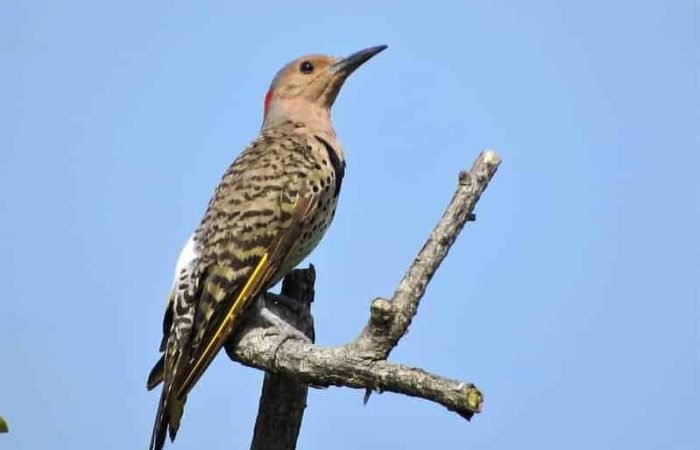
There has been eleven species of woodpeckers spotted in Michigan, although only eight are common residents of the Wolverine State.
Some common locations for woodpeckers in Michigan are woodland swamps (hairy woodpeckers), pine forests, suburban environments, apple orchards, and more.
Some parks that are known for being great spots to view woodpeckers are Old Mission Lighthouse Park (red-headed woodpeckers), Grand Traverse Commons, Sleepy Hollow State Park, and Lincoln Brick Park in Eaton County.
Lincoln Brick Park is also notable for hosting Golden Eagles, an added bonus for any avid bird watcher.
Want to learn more? Take a look at the North American Guide to Woodpeckers
Michigan offers unique environments when compared with many other states, due to its dual peninsula setup and frontage on multiple Great Lakes.
This allows a wide range of woodpeckers to find suitable habitats and feeding opportunities in Michigan.
Many Michigan residents enjoy searching for woodpeckers in the winter months, since many other animals will shelter or migrate for the cold Michigan winters.
However, many woodpeckers do not migrate and are one of the few species that can keep a Michigan bird watcher busy in the winter season.
Two of the most common Michigan woodpeckers, hairy woodpeckers and downy woodpeckers (also notable for their striking resemblance), can be found on forest trails and swampland throughout the coldest months.
In the spring, many Michigan residents and visitors can hear the trademark drumming noise that many woodpecker species will make to attract mates, and it is a signal of warmer weather to come. Michigan is a woodpecker haven due to its unique habitat and dietary offerings.
Take a look at our article on How to Attract Woodpeckers?
What Woodpeckers can be seen in Michigan?
Table of Contents
1. Red-bellied Woodpecker
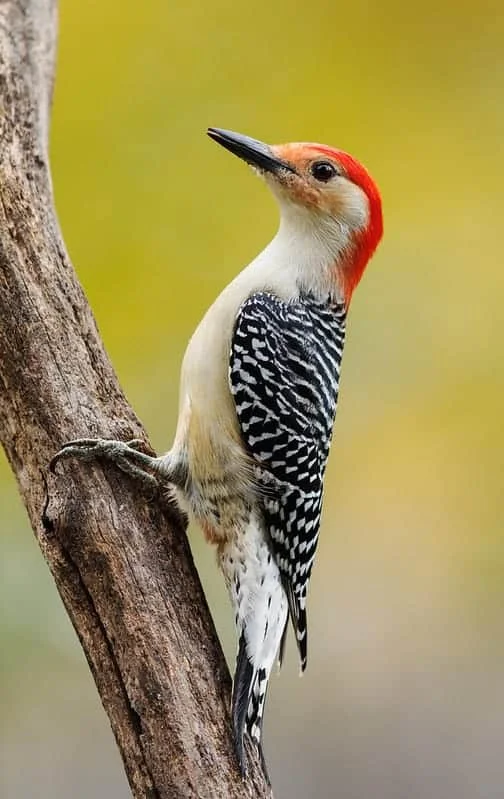
Wingspan
15-18 inches
Weight
2.65 ounces
Life Expectancy
12 years
Diet
Insects
Red-bellied woodpeckers are a somewhat puzzling case to bird watchers because the red hue in their bellies is often unnoticeably faint.
Males have red heads, and both genders of red-bellied woodpeckers have black and white striping on their backs that zig zag in random directions, much like that of a zebra.
They like to dwell in wooded areas and even suburban communities, with the only prerequisite to their habitat being that they prefer deciduous trees.
In recent times, the range for red-bellied woodpeckers has stretched further to the north, allowing them to become more prominent in places like Michigan.
Although the males have red heads, try to refrain from confusing them with red-headed woodpeckers (mentioned previously on this list), their name and their markings do not seem to match at first glance.
They are larger than average for a woodpecker species.
When can this bird be seen in the state?
Red-bellied woodpeckers are found throughout all seasons in Michigan.
If the weather gets too bitterly cold, they can be forced south, although they aren’t a migratory bird. Generally, they stay for the winters.
Where can this bird be seen in the state?
Red-bellied woodpeckers are most common in the southern half of the lower peninsula.
However, as mentioned earlier, they have been observed to be more present each year in northern locations. So, although they are not common in the upper peninsula currently, there are more sightings up north as time goes on.
2. Downy Woodpecker
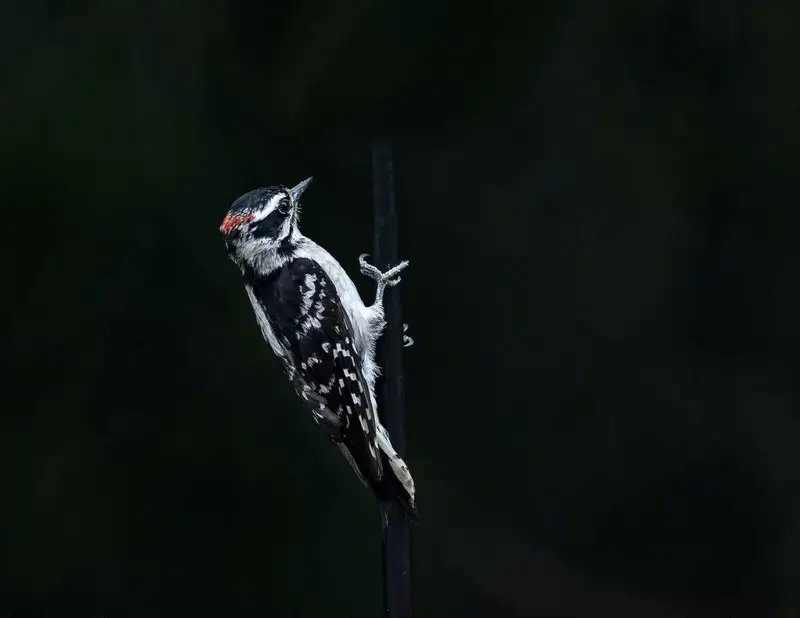
Wingspan
3.27 to 4.13 inches
Weight
0.75 to 1 ounce
Life Expectancy
12 Years
Diet
Insects & Non-insect arthropods
Downy woodpeckers are the smallest woodpeckers native to North America. They are often found at feeders since they love nuts and seeds.
They are not migratory and are able to tolerate Michigan winters with ease. Some even report that it is common for downy woodpeckers to drink from hummingbird feeders.
They only live in dead trees or dead tree limbs, and also hammer away at dead trees to find insects within.
They are white and black, which white spots on their black wings and a red spot on their head for males.
When can this bird be seen in the state?
Downy woodpeckers are found during all seasons in Michigan. They do not migrate and can easily tolerate the winters.
Where can this bird be seen in the state?
Downy woodpeckers are some of the most common woodpeckers in the state and are found all over the state.
3. Hairy Woodpecker
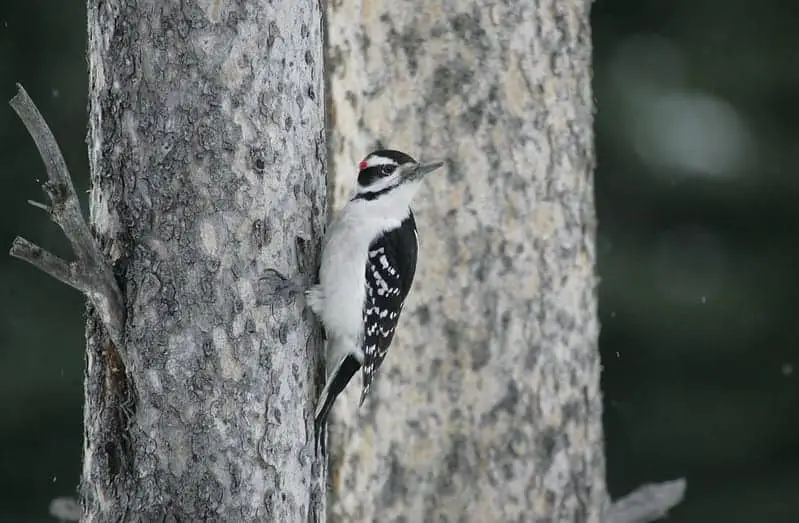
Wingspan
15 inches
Weight
1.4 to 3.4 ounces
Life Expectancy
15 years
Diet
Wood-boring insects & tree sap
Hairy woodpeckers are markedly similar to downy woodpeckers, the predecessor on this list.
They are larger and more uncommon than downy woodpeckers, but their markings and colouring are so similar that they are often confused.
Hairy woodpeckers are some of the most energetic and strong woodpeckers in North America pound-for-pound and are known to be able to excavate deeper into trees than most other woodpeckers in search of wood-boring insect larvae.
If you see a hairy woodpecker at work, you will notice them ripping off large chunks of bark, and incessantly pounding at the tree limb or trunk with their beak.
They can be run off from their nesting cavities by sparrows or starlings.
They are highly adaptable and in turn have a massive range spanning over almost the entire United States and Canada, the only prerequisite is that they need large trees to dwell and feed from.
When can this bird be seen in the state?
Hairy woodpeckers are found in Michigan during all seasons. They are not migratory birds and will remain even in cold Michigan winters, although extreme bitter colds might drive them south, but not on an annual basis.
Where can this bird be seen in the state?
Hairy woodpeckers can be seen all over the state of Michigan. Since they are adaptable, they can be found nearly anywhere as long as there are large trees present for them to nest in and feed from.
4. Pileated Woodpecker
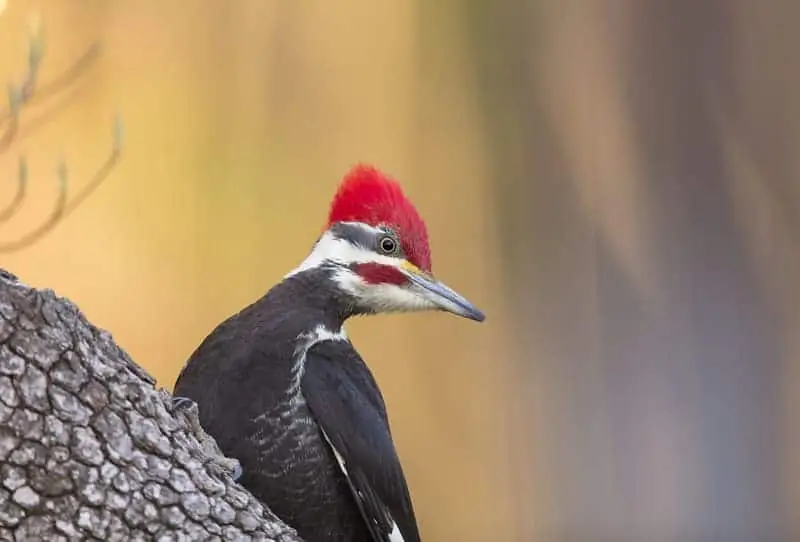
Wingspan
26 to 30 inches
Weight
8.8 to 14.1 ounces
Life Expectancy
13 years
Diet
Fruit, nuts & insects
Pileated woodpeckers are the largest woodpecker species in North America (if you assume that the Ivory-billed Woodpecker is truly extinct!).
They are common visitors to suet feeders but are shy and are easily spooked by humans.
Pileated woodpeckers love dead trees and tree stumps and will excavate them for their nests and also that is where they will drill to retrieve insects such as carpenter ants, beetle larvae, and termites.
They also commonly eat fruits and nuts. They are easily identifiable by their huge size and massive red mohawk.
When can this bird be seen in the state?
Pileated woodpeckers are found in Michigan throughout all seasons.
Where can this bird be seen in the state?
Pileated woodpeckers are found in all parts of Michigan, but are less common in the south eastern portion of the state.
5. Northern Flicker
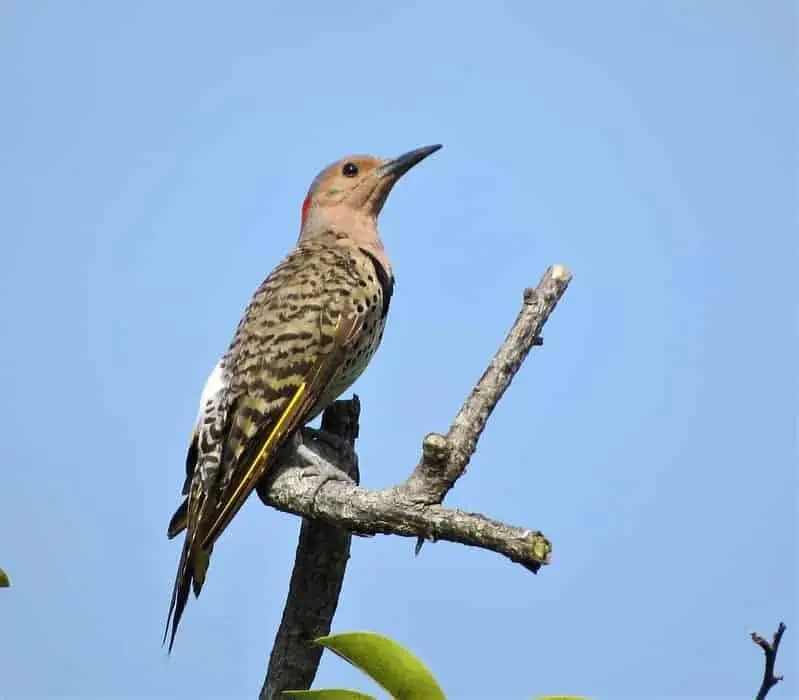
Wingspan
21.3 inches
Weight
6 ounces
Life Expectancy
9 Years
Diet
Insects, seeds, nuts & fruit
Northern flickers are unusual in that they do not hammer away at trees very often, but rather feed mostly off the ground, eating insects such as ants.
The only time that they will drum on trees is usually to communicate with other northern flickers in the area.
They have black spotted white underbellies with yellow-lined tails and red tipped heads.
Males will have black marks on their cheeks that make it look like they have a moustache.
Since they do not have the ability to excavate as well as other woodpeckers, they usually live in pre-existing cavities in trees or elsewhere.
They have a remarkably large range and are adaptable to multiple climates. They are larger than average for a woodpecker species.
Where can this bird be seen in the state?
Northern flickers are found in Michigan during all seasons. They are a highly adaptable species that can tolerate many climates.
Where can this bird be seen in the state?
Northern flickers are found in all parts of Michigan due to their high adaptability and large range.
6. Lewis's Woodpecker
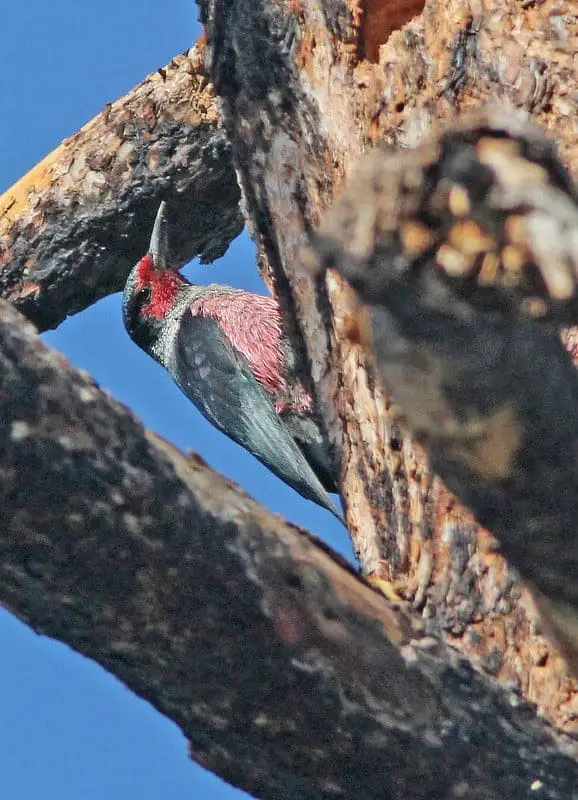
Wingspan
11 inches
Weight
4 ounces
Life Expectancy
4-11 Years
Diet
Insects & Nuts
Lewis’s woodpecker is certainly a woodpecker like no other.
Differing greatly from other woodpecker species, Lewis’s woodpecker hunts for insects like a flycatcher, by perching on trees or branches as many woodpeckers do, but rather than excavating for insects, they will lookout for bugs to fly by and will chase after them in mid-air.
Even their flight is different from woodpeckers in that they take slow, gliding, and strong wingbeats, more similar to crows than woodpeckers.
They have unique colouring as well, pink bellies with a grey ring around their neck, and a dark green back with a crimson face. They are capable of digging into trees as woodpeckers do, but rarely do so.
They travel a lot and are found in spacious pine forests and woodlands, but usually only settle down to breed, otherwise they are on the go.
Lewis’s woodpecker is actually considered an “accidental bird” since they are not normally found near Michigan.
When can this bird be seen in the state?
Lewis’s woodpeckers are not commonly found in Michigan, but when they are spotted in Michigan it is during late spring or early summer.
Where can this bird be seen in the state?
Lewis’s woodpeckers have been spotted near Detroit only a handful of times, otherwise they mostly reside in the western United States.
Look for them to be perched in trees hunting for flying bugs or scavenging for nuts.
7. Red-Headed Woodpecker
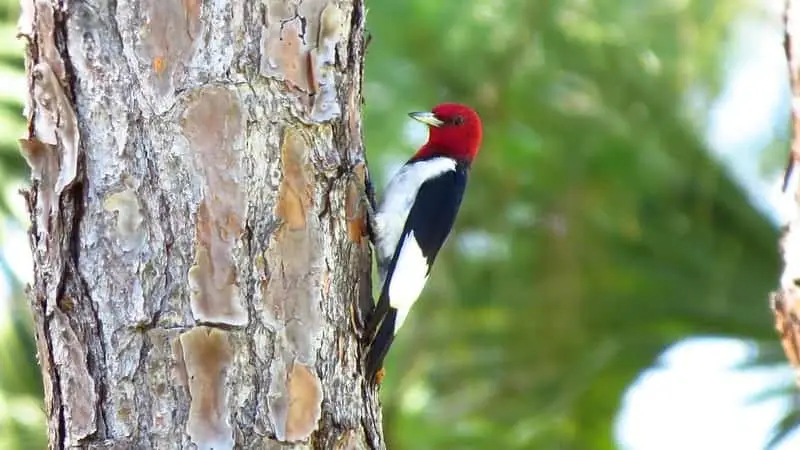
Wingspan
16 inches
Weight
2.5 ounces
Life Expectancy
9 Years
Diet
Insects & Berries
Red-headed woodpeckers are undoubtedly some of the most beautiful woodpecker species out there.
With crimson heads and elegant black and white markings throughout the rest of their body, they are a sight to behold. Young red-headed woodpeckers will have brown heads rather than the trademark red colour.
Their colouring is different from many woodpeckers in that they are marked in a colour blocking fashion, with pure white bellies and pure black backs with white lower halves of their wings that match their belly.
They like to dwell in spacious forests with high branches and an open and clear ground level, such as pine farms.
They travel in groups and gather nuts and hunt insects that they sight from tree perches. They are cavity nesters and store leftover food in their cavities for later.
They like to hunt bugs out of the air, which like the Lewis’s woodpecker is an unusual trait. They used to be more prominent but have seen declining populations recently.
When can this bird be seen in the state?
Red-headed woodpeckers are only found in Michigan during winter and breeding season. They can be found year-round in locations just south of Michigan.
Where can this bird be seen in the state?
Red-headed woodpeckers can be found in the upper peninsula only during breeding season, and in the lower peninsula during breeding season and winter.
They like orchards and forests, spaces where the lower level beneath the branches of the trees are clear, so that they can better see bugs.
8. American Three-toed Woodpecker
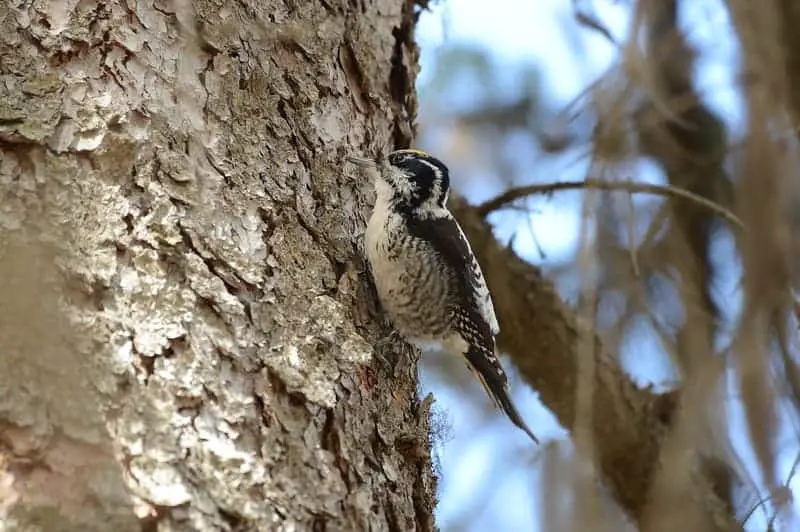
Wingspan
15 inches
Weight
2 ounces
Life Expectancy
6 Years
Diet
Beetle Larvae, insects & fruit
The American Three-toed woodpecker is not a common sighting in Michigan, but they have been spotted before.
They are unique to many birds on this list for mainly being spotted further north of Michigan rather than south. This means that they can tolerate colder temperatures and bitter winters better than most birds.
They are credited with being able to bring down the population of spruce bark beetles, which are considered pests by many.
They are a calm natured bird, and sometimes look fake since they are able to sit perfectly still for long periods of time.
They do not pound at trees as much as other woodpecker species, but rather they get most of their food by ripping off pieces of bark and eating whatever insects are available underneath.
They are tolerant of people and their calm demeanour remains even when outsiders approach their nest.
Their name is an acknowledgement of the fact that they have three toes, which varies from most woodpeckers that have four toes.
When can this bird be seen in the state?
They can be seen in Michigan during all seasons even though Michigan is technically just out of their range. Some stragglers will be spotted from time to time.
Where can this bird be seen in the state?
American three-toed woodpeckers are not native to Michigan, but they can be spotted in the upper peninsula, since the lower border of their range extends just to the north of the upper peninsula.
9. Black-Backed Woodpecker
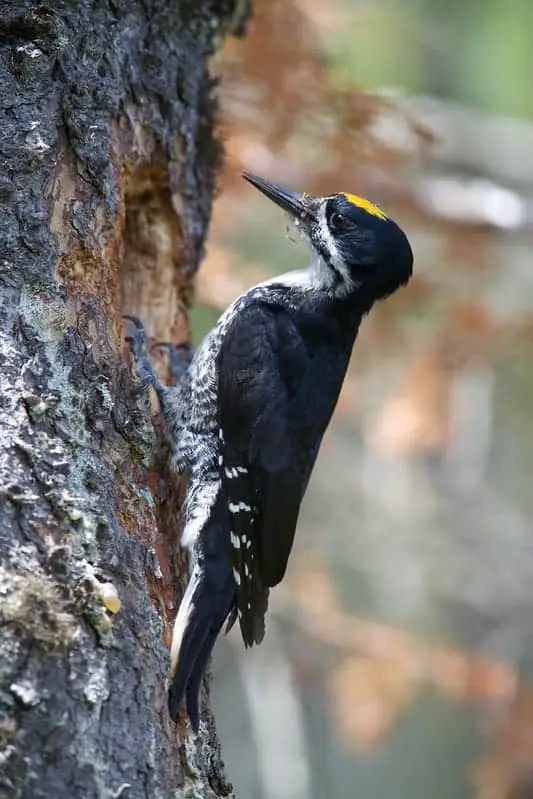
Wingspan
16 inches
Weight
2.5 ounces
Life Expectancy
8 Years
Diet
Wood-boring Beatles, fruit & nuts
Black-backed woodpeckers are black with white undersides and males will have a yellow crown on top of their heads.
They will dig into tree trunks and limbs for boring beetle larvae and love to live and feed in burnt forests, even more so than other woodpecker varieties.
They do not use the same nest twice and will dig a new nest into a tree for each breeding cycle.
Many other birds will use their vacated cavity nests after they abandon them, including chickadees, bluebirds, and owls.
They are not a common occurrence anywhere in the world, and they bear a resemblance to the American Three-Toed Woodpecker.
However, they are more dominant than three-toed woodpeckers and will sometimes drive them away from their nests, a major problem for American three-toed woodpeckers, since their ranges and habitats are virtually identical.
Black-backed woodpeckers also are not as timid and calm as American Three-Toed woodpeckers.
Their range mostly includes only the upper peninsula of Michigan, although they can be found in the lower peninsula very rarely.
When can this bird be seen in the state?
Black-backed woodpeckers can be found in Michigan throughout all seasons. Their range extends much further to the north in Canada, so they are able to easily tolerate cold Michigan winters.
Where can this bird be seen in the state?
Black-backed woodpeckers are usually only found in the upper peninsula of Michigan, and even still they are not a common occurrence. They can be found in the lower peninsula very rarely.

More Articles.
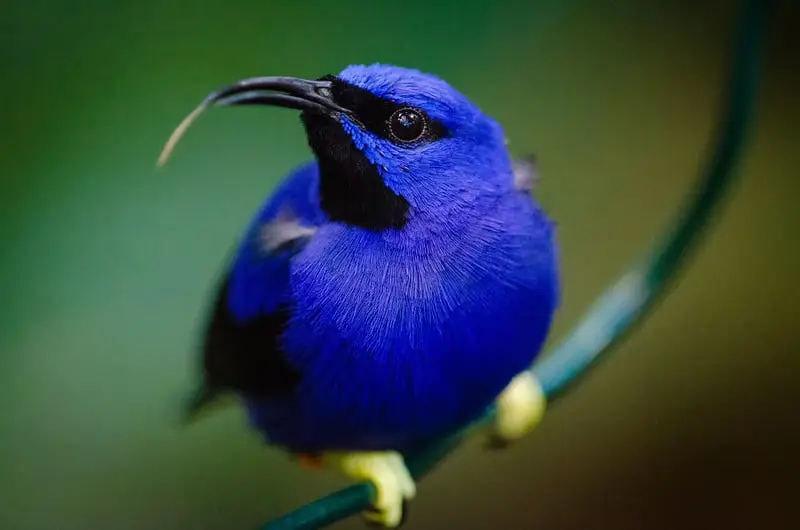
North American Birds with Blue Heads (16 Species with Pictures and Sounds)
North America is filled with many wonderful birds with blue heads – in fact, there
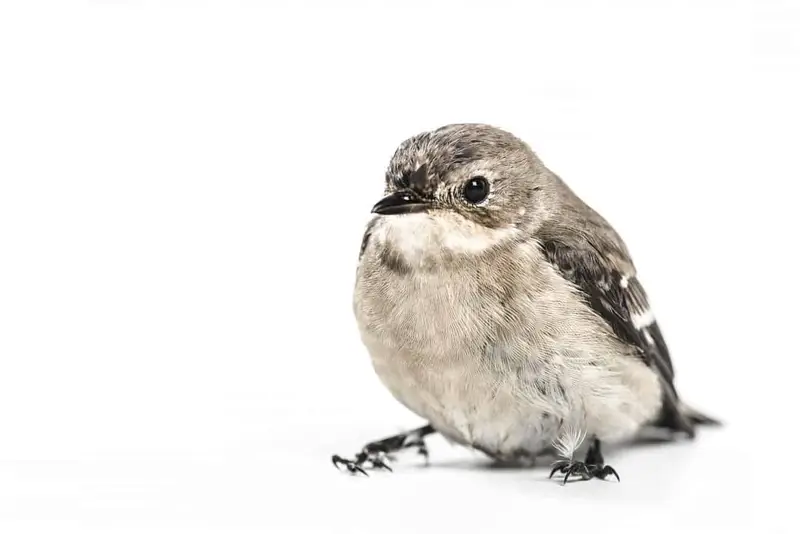
How to attract Chickadees to your yard?
Chickadees, despite their strange name, are a staple of the countryside across all of North
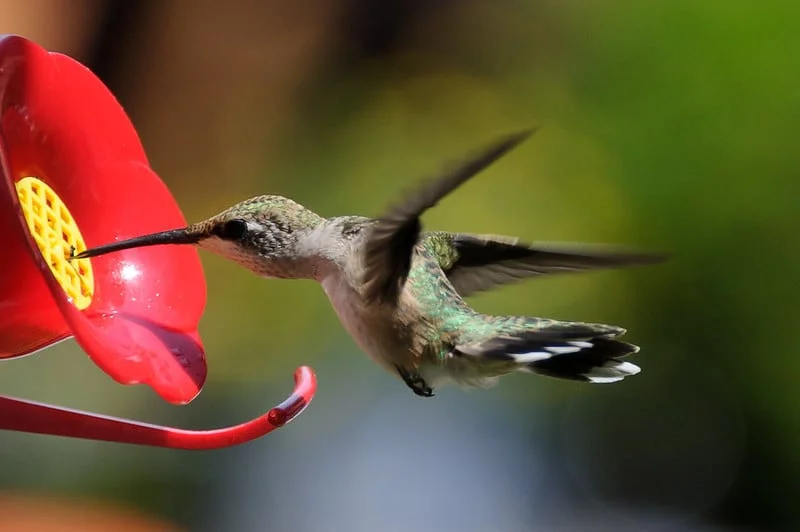
What time of day should you feed hummingbirds?
Hummingbirds are most known to prefer to visit a feeder and flowers as the sun

About Us
We are avid bird-watchers who recently retired, allowing us more time to travel the world. Fortunately, we have managed to visit numerous countries around Europe, Asia, and America. Watching and photographing birds has been a passion for many years and we are making the most of the extra time on our hands!
